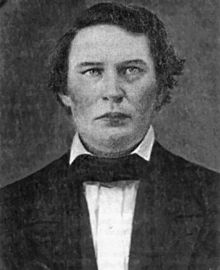George W. Johnson | |
|---|---|
 | |
| 1st Confederate Governor of Kentucky | |
| In office November 20, 1861 – April 8, 1862 | |
| Lieutenant | Horatio F. Simrall |
| Preceded by | Office established |
| Succeeded by | Richard Hawes |
| Member of the Kentucky House of Representatives from the Scott County district | |
| In office 1838–1840 | |
| Personal details | |
| Born | George Washington Johnson May 27, 1811 Scott County, Kentucky, U.S. |
| Died | April 8, 1862 (aged 50) Shiloh, Tennessee, U.S. |
| Resting place | Georgetown Cemetery, Georgetown, Kentucky, U.S. |
| Political party | Democratic |
| Spouse | Ann Eliza Viley (1833–1862) |
| Children | 10 |
| Alma mater | Transylvania University |
| Occupation | Farmer |
| Profession | Legal |
| Committees | Committee of Sixty |
| Military service | |
| Allegiance | |
| Branch/service | |
| Years of service | 1862 |
| Rank | Private |
| Unit | 4th Kentucky Infantry Regiment |
| Battles/wars | American Civil War |
George Washington Johnson (May 27, 1811 – April 8, 1862) was the first Confederate governor of Kentucky. A lawyer-turned-farmer from Scott County, Kentucky, Johnson, a supporter of slavery who owned 26 slaves, favored secession as a means of preventing the Civil War, believing the Union and Confederacy would be forces of equal strength, each too wary to attack the other.[1] As political sentiment in the Commonwealth took a decidedly Union turn following the elections of 1861, Johnson was instrumental in organizing a sovereignty convention in Russellville, Kentucky, with the intent of "severing forever our connection with the Federal Government."[2] The convention created a Confederate shadow government for the Commonwealth, and Johnson was elected its governor. This government never controlled the entire state though it controlled about half the state early in the war, Kentucky remained in the Union after 1862 throughout the rest of the war.
Despite his meager political experience—having previously served only three years in the Kentucky House of Representatives—Johnson labored vehemently to ensure the success of the shadow government. Kentucky was admitted to the Confederacy on December 10, 1861, but the shadow government's influence in the Commonwealth extended only as far as the Confederate Army advanced. When Albert Sidney Johnston abandoned the Confederate capital of Bowling Green, Johnson and the other government officials accompanied him. Despite his advanced age and a crippled arm, Johnson volunteered for military service in General Johnston's army. Johnson was killed at the Battle of Shiloh. He was succeeded by Richard Hawes, the second and last governor of Confederate Kentucky.
- ^ Columnist, James Bartek Guest (March 11, 2020). "Plaque incompatible with library mission". News-Graphic.com. Retrieved July 18, 2023.
- ^ Neace, James Clell; Harned, Edgar Porter (2000). "Kentucky Had Two Confederate Governors". Retrieved June 9, 2009.